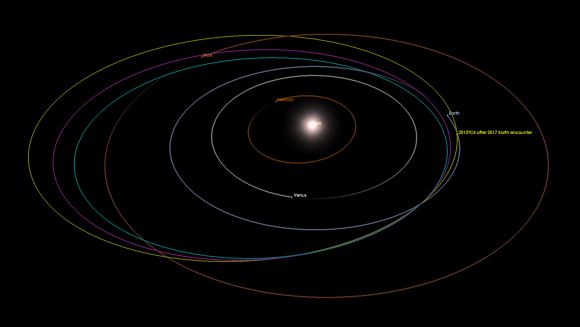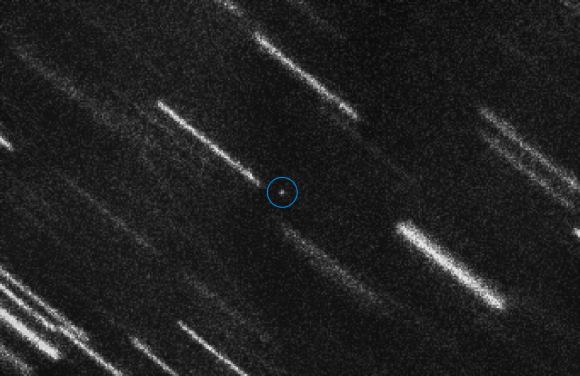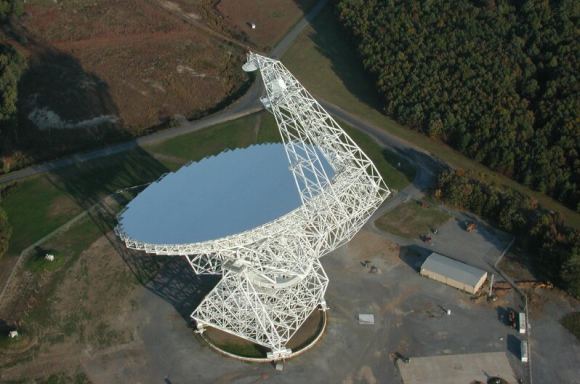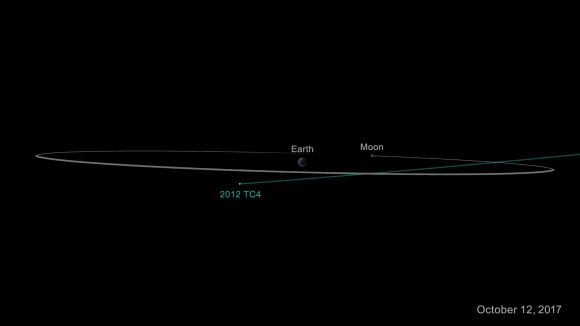Beyond the Earth-Moon system, thousands of asteroids known as Near-Earth Objects (NEOs) are known to exist. These rocks periodically cross Earth's orbit and make close a flyby of Earth. Over the course of millions of years, some even collide with the Earth, causing mass extinctions. Little wonder then why NASA's Center for Near Earth Object Studies (CNEOS) is dedicated to monitoring the larger objects that occasionally come close to our planet.
One of these objects is 2012 TC4, a small and oblong-shaped NEO that was first spotted in 2012 during a close flyby of Earth. During its most recent flyby - which took place on Thursday, October 12th,2017 - an international team of astronomers led by NASA scientists used the opportunity to conduct the first international exercise to test global responses to an impending asteroid strike.
This exercise was known as the "TC4 Observation Campaign", which began this past July and concluded with the asteroid flyby. It all began when astronomers at the European Southern Observatory's (ESO) Paranal Observatory in Chile used the Very Large Telescope (VLT) to recover 2012 TC4. When the asteroid made its final close approach to Earth in mid-October, it passed Earth by at a distance of 43,780 km (27,200 mi).

Diagram showing 2012 TC4's heliocentric orbit, which has changed due to the 2012 and 2017 close encounters with Earth. Credit: NASA/JPL-Caltech
The goal of this exercise was simple: recover, track and characterize a real asteroid as if it were likely to collide with Earth. In addition, the exercise was an opportunity to test the International Asteroid Warning Network, which conducts observations of potentially hazardous asteroids, attempts to model their behavior, make predictions, and share these findings with institutions around the world.
On Oct. 12th, TC4 flew by Earth at roughly 0.11 times the distance between Earth and the Moon. In the months leading up to the flyby, astronomers from the US, Canada, Columbia, Germany, Israel, Italy, Japan, the Netherlands, Russia and South Africa tracked TC4 from the ground. At the same time, space-based telescopes studied the asteroid's orbit, shape, rotation and composition.
Detlef Koschny is the co-manager of the Near-Earth Object segment in the European Space Agency (ESA)'s Space Situational Awareness program. As he was quoted in a recent NASA press release:
"This campaign was an excellent test of a real threat case. I learned that in many cases we are already well-prepared; communication and the openness of the community was fantastic. I personally was not prepared enough for the high response from the public and media - I was positively surprised by that! It shows that what we are doing is relevant."

Asteroid 2012 TC4 appears as a dot at the center of this composite of 37 individual 50-second exposures obtained on Aug. 6, 2017 by the European Southern Observatory's Very Large Telescope. Credit: NASA/JPL-Caltech
Based on their observations, scientists at CNEOS - which is located at the Jet Propulsion Laboratory in Pasadena, California - were able to determine all the necessary characteristics of TC4. This included its precise orbit, the distance it would pass by Earth on Oct. 12th, and discern if there was any possibility of a future impact. As Davide Farnocchia, a member of CNEOS who led the effort to determine the asteroid's orbit, explained:
"The high-quality observations from optical and radar telescopes have enabled us to rule out any future impacts between the Earth and 2012 TC4. These observations also help us understand subtle effects such as solar radiation pressure that can gently nudge the orbit of small asteroids."
Multiple observatories also dedicated their optical telescopes to studying how fast TC4 rotates. As Eileen Ryan - the director of the Magdalena Ridge Observatory, which conducted observations of the asteroids rotation - indicated, "The rotational campaign was a true international effort. We had astronomers from several countries working together as one team to study TC4's tumbling behavior."
What they found that the small asteroid rotated slowly, which was rather surprising. Whereas small asteroids typically rotate very quickly, TC4 had a rotational period of just 12 minutes, and also appeared to be tumbling. Other observations revealed some interesting things about the shape of TC4.

The Green Bank Telescope, located in West Virginia. Credit: NRAO
These were conducted by astronomers using NASA's Goldstone Deep Space Network antenna in California, and the National Radio Astronomy Observatory's Green Bank Telescope in West Virginia. Their reading helped refine size estimates of the asteroid, indicating that it is elongated and measures approximately 15 meters (50 ft) long and 8 meters (25 feet) wide.
Determining TC4's composition was more challenging. Due to unfavorable weather conditions that coincided with the flyby, instruments like NASA's Infrared Telescope Facility (IRTF) at the Mauna Kea Observatory in Hawaii were unable to get a good look at the asteroid. However, spectra was obtained on the asteroid that indicated that it has a rocky body, which means it is an S-type asteroids.
Typically, ground-based elements determine an asteroid's composition based on their color. Whereas dark asteroids are known for being carbon-rich (C-type), bright asteroids are predominantly composed of silicate minerals (S-type). As Lance Benner, who led the radar observations at JPL, explained:
"Radar has the ability to identify asteroids with surfaces made of highly reflective rocky or metallic materials. We were able to show that radar scattering properties are consistent with a bright rocky surface, similar to a particular class of meteorites that reflect as much as 50 percent of the light falling on them."
In addition to the observation campaign, NASA used TC4's latest flyby as an opportunity to test communications between observatories, as well as the internal messaging and communications system that is currently in place. This network connects various government agencies and the executive branch and would come into play in the event of a predicted impact emergency.

Asteroid 2012 TC4 projected flyby of the Earth-Moon system, which was calculated well before it took place. Credits: NASA/JPL-Caltech
According to Vishnu Reddy, an assistant professor from the University of Arizona's Lunar and Planetary Laboratory who led the observation campaign, this aspect of the exercise "demonstrated that we could organize a large, worldwide observing campaign on a short timeline, and communicate results efficiently."Michael Kelley, the TC4 exercise lead at NASA Headquarters in Washington, added,"We are much better prepared today to deal with the threat of a potentially hazardous asteroid than we were before the TC4 campaign."
Last, but not least, was the way the exercise brought scientists and institutions from all around the world together for a single purpose. As Boris Shustov - the science director for the Institute of Astronomy at the Russian Academy of Sciences, who was also part of the exercise - indicated, the exercise was an excellent way to test how the world's scientific institutions would go about prepping for a possible asteroid impact:
"The 2012 TC4 campaign was a superb opportunity for researchers to demonstrate willingness and readiness to participate in serious international cooperation in addressing the potential hazard to Earth posed by NEOs. I am pleased to see how scientists from different countries effectively and enthusiastically worked together toward a common goal, and that the Russian-Ukrainian observatory in Terskol was able to contribute to the effort. In the future I am confident that such international observing campaigns will become common practice."
In the event that a Near-Earth asteroid might actually pose a threat the Earth, it is good to know that all the tracking, monitoring and alert systems we have in place are in good working order. If we are going to trust the fate of human civilization (and possibly all life on Earth) to an advanced warning system, it just makes sense to have all the bugs worked out beforehand!
The TC4 Observation Campaign is sponsored by NASA's Planetary Defense Coordination Office, which in turn is managed by the Planetary Science Division of the Science Mission Directorate at NASA Headquarters in Washington, D.C.
Further Reading: NASA
No comments:
Post a Comment